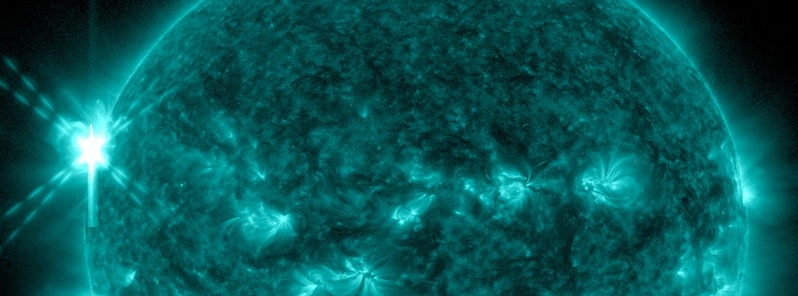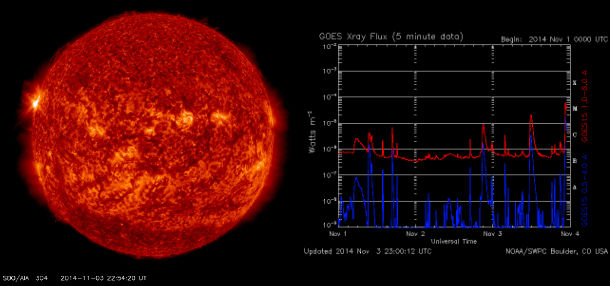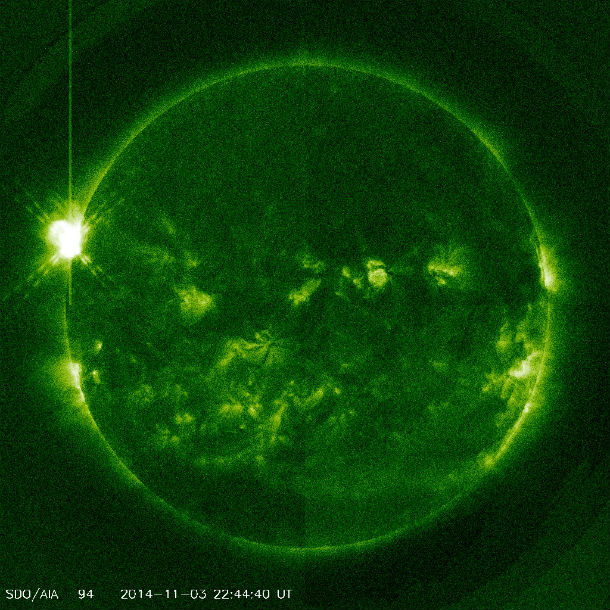Moderately strong M6.5 solar flare erupted off the northeast limb

Another M-class solar flare was recorded around new region approaching from the northeastern limb. After M2.2 at 11:53, an M6.5 peaked at 22:40 UTC on November 3, 2014. The event started at 22:15 UTC and ended at 22:53 UTC.
The actual eruption was probably much stronger than its nominal classification due the location and eclipse of the flare.

.png)
A 10cm radio burst was registered at 22:31 UTC, peaking at 180 sfu. 10cm radio burst can cause interference for sensitive receivers including radar, GPS, and satellite communications.
Additionally, a Type II radio emission with estimated velocity of 601 km/s was associated with the event. Type II emissions occur in association with eruptions on the sun and typically indicate a coronal mass ejection is associated with a flare event.
***
Space Weather Message Code: SUM10R
Serial Number: 640
Issue Time: 2014 Nov 03 2254 UTC
SUMMARY: 10cm Radio Burst
Begin Time: 2014 Nov 03 2230 UTC
Maximum Time: 2014 Nov 03 2231 UTC
End Time: 2014 Nov 03 2239 UTC
Duration: 9 minutes
Peak Flux: 180 sfu
Latest Penticton Noon Flux: 125 sfu
Description: A 10cm radio burst indicates that the electromagnetic burst associated with a solar flare at the 10cm wavelength was double or greater than the initial 10cm radio background. This can be indicative of significant radio noise in association with a solar flare. This noise is generally short-lived but can cause interference for sensitive receivers including radar, GPS, and satellite communications.
***
Space Weather Message Code: ALTTP2
Serial Number: 977
Issue Time: 2014 Nov 03 2317 UTC
ALERT: Type II Radio Emission
Begin Time: 2014 Nov 03 2233 UTC
Estimated Velocity: 601 km/s
Description: Type II emissions occur in association with eruptions on the sun and typically indicate a coronal mass ejection is associated with a flare event.

SDO's AIA 094 recorded M6.5 flare at 22:44 UTC on November 3, 2014. (Courtesy of NASA/SDO and the AIA, EVE, and HMI science teams)
This incoming active region already produced coronal mass ejections while traversing the farside and is just about to turn into view off the northeast limb. We can expect moderate to high solar activity from this active region during its transition through the Earth-facing side of the sun.
Under the influence of a coronal hole high speed stream, solar wind conditions may become slightly elevated in the next 24 to 48 hours with associated unsettled and possibly active geomagnetic conditions.
The proton flux has been increasing and decreasing several times since November 1 at 14:30 UTC. The sequence of several rises indicates the relation with several solar events. Further increases of the proton flux and in the next 24 hours are likely, with chances for a stronger proton event.
.png)
Featured image: NASA SDO AIA 131

Commenting rules and guidelines
We value the thoughts and opinions of our readers and welcome healthy discussions on our website. In order to maintain a respectful and positive community, we ask that all commenters follow these rules.